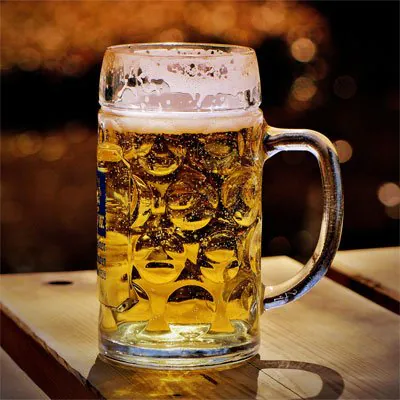The market for gluten-free foods is growing. In the meantime, people with celiac disease no longer have to do without certain stimulants.
While per capita alcohol consumption in Switzerland has been falling for years, it has remained stable for beer at around 51 liters. This makes it the most consumed alcoholic beverage in Switzerland. However, people who suffer from gluten intolerance have to do without the classic beer refreshment. Finally, beer grains such as barley or wheat contain gluten. The alternative for allergy sufferers: gluten-free beer. In addition to bread, pizza or cake without gluten, the stimulant is now a niche product on more and more supermarket shelves.
Gluten – the common sticky protein
Gluten is a protein found in many grains such as wheat, rye and barley. Due to its shaping properties, it is also referred to as glue or adhesive protein. For example, if grain flour is mixed with water or another liquid, the gluten from the flour forms an elastic mass – the dough. In Switzerland, around 80,000 people suffer from gluten intolerance, known as celiac disease. The gluten damages the mucous membrane of the small intestine. Typical complaints are diarrhoea, nausea, abdominal pain, and an overall poor general condition. Because the small intestine becomes permanently inflamed in celiac disease, the nutrients are no longer absorbed by the body to the normal extent – deficiency symptoms occur. While people with lactose intolerance can take lactase tablets before eating lactose-containing foods to avoid symptoms, there is only one effective treatment for people with celiac disease: a gluten-free diet. If all foods containing gluten are consistently avoided, those affected can usually live a healthy, symptom-free life.
Gluten-free beer: How it’s brewed
According to EU guidelines, in order to be declared gluten-free, a beer must contain less than 20 milligrams per kilogram (0.002%) of gluten. Since classic beers are made from barley or wheat, they usually contain gluten – depending on the type of beer and type of grain, around 10 to 20 mg per kilogram. Normal wheat beer contains a lot of gluten. With a good 250 milligrams per liter, its consumption must be avoided in any case by allergy sufferers.
Brew beer from corn, millet, and others
There are several ways to make gluten free beer. For example, types of grain such as rice, millet, corn, or soya are used. The advantage: the later beer is completely gluten-free. In terms of taste, however, it cannot be compared to traditional beer. – At least if standard European taste is assumed. As newcomers, corn and millet beers have only been available on the market in Europe for a few years. In other parts of the world, however, they have been around for a long time. For example, corn beer is a popular traditional drink among some peoples in South Africa.
Brew traditionally and remove gluten
Western breweries in particular want to taste as close as possible to the original with the gluten-free beer – similar to the non-alcoholic versions. Therefore, the beer is first brewed traditionally. By adding enzymes, the gluten is removed during the manufacturing process, and the typical beer taste is retained. The enzymes break down the gluten into small peptides that are tolerable for people with celiac disease. Important to know: Even after the enzymatic degradation, these beers still contain small traces of gluten. People with a pronounced gluten intolerance should therefore resort to grain alternatives.
Innovative processes and new breeds
In the beginning it was small breweries that brought gluten-free beer onto the market as a niche product, but nowadays there are also offers from large breweries. After all, the market for gluten-free food and beverages is becoming increasingly popular. Therefore, research into innovations in the manufacturing process continues. For example, some breweries use specially bred gluten-free barley as a raw material in order to be able to produce the popular standard beer without gluten. Others rely on traditional raw materials but change the brewing process. Instead of working with enzymes, the beer is boiled more intensively and for longer and stored at a colder temperature. Finally, it is filtered to comply with EU guidelines.
What many people don’t know is that there are also traditionally brewed beers that are low in gluten. For example, a Pilsner lager beer contains only 1.2 milligrams of gluten per 100 grams – and can therefore be labelled as gluten-free according to the EU directive.
Production of gluten-free beer – what manufacturers have to consider
Both conventional and gluten-free products are often produced in one company. Manufacturers must ensure strict controls and absolute hygiene. All means of production must be cleaned regularly – even in inaccessible places. In the entire supply chain and in the brewing process, all ingredients must be strictly separated from raw materials containing gluten. In principle, gluten-free beer should be brewed in equipment that is used exclusively for this purpose. This is the only way to avoid contamination.
Important for export: Different requirements apply to gluten-free foods in different countries. If a beer is to be sold within the EU, the limit of 20 mg/kg must not be exceeded. In the USA, on the other hand, the same limit applies as in the EU, but if the gluten has been removed during the manufacturing process, a beer cannot be declared gluten-free there. – Even if it contains less than 20 mg of gluten.
In addition to strictly separate production and high hygiene standards, manufacturers have to use specialized random tests to ensure that their products are gluten-free. Special laboratories such as Biolytix offer reliable evidence for various foods. With tried and tested methods such as the ELISA TEST, the gluten content in the beer is determined and it is ensured that the end product is free of the sticky protein and is allowed to bear the seal with the crossed-out ear of corn.




